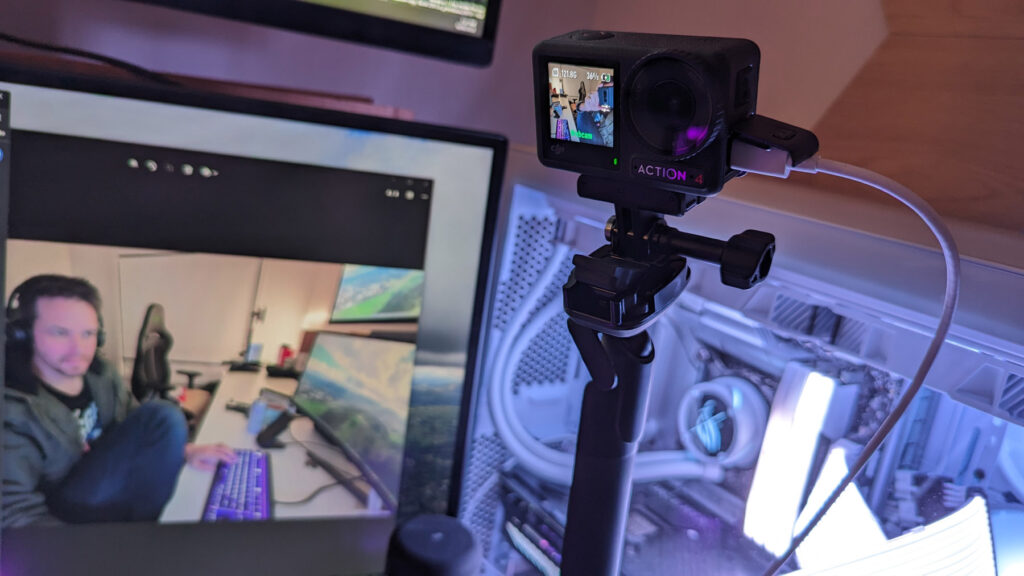After being announced this week, the DJI OSMO Action 4 has arrived and today I had a chance to go hands-on. This post focuses on my first impressions of the action camera, with a background of using the GoPro Hero series for the past 6 years.
As I began unboxing the OSMO Action 4, it struck me that I hadn’t really considered what expectations I should have of the product, I last looked at DJI action cameras when they released the Action 2 camera and while there were some unique ideas there, with the clip-on system, it didn’t set the world on fire and was prone to overheating.
The magnetic clip system is back again and I actually prefer it to other quick-release systems that are often, not so quick to release.












It was clear there was a fair bit of effort put into making the packaging as efficient as possible.
Something I was pleasantly surprised to see was just how far the extension rod extended. Most tripods that I’d used with action cams previously were 30-50cm long, but this was nearly 3 times longer at 145cms (the label says 1.5m).
Having the camera this far away means you can capture the world from new perspectives, particularly from height, I guess DJI figures you’d use a drone if you need to go higher than this.
















The triple battery pack is really nice, this is something unique to DJI, not something we’ve seen from GP. DJI offers triple-charging docks for their drones when you buy their ‘Fly more’ combos. Taking that technology and offering it here makes a lot of sense, assuming the reason they did so, isn’t because each battery doesn’t last long enough.. full review is required for that one.
Having just finished the Air 3 review where we saw the party trick of being able to transfer the remaining charge of one battery to another, I hoped it was included here, but unfortunately not. Still, the charging dock feels like it’s built well and a quality product. It simplifies charging multiple batteries just connect 1x USB-C cable and the dock takes care of the rest.






There are obvious similarities here, while also featuring an important difference. The screws to mount the camera have a dual-head, which provides an easy grab point to twist and tighten, a big improvement over the difficult-to-tighten alternative that frankly hurt your fingers.
Their similarities are fortunately close enough that other action cam accessories work with this product, something that was clearly by design and not an accident. While this is a bit cheeky, this ultimately benefits consumers who can mount this device to existing accessories like suction cups, clamp mounts and more.
















The display offers a familiar experience, with easy-to-select menu items, swipe gestures and more.
There Action 4 cam offers a similar-sized touchscreen on the back, but goes one better, offering a touchscreen on the front as well.
You can select from shooting modes that include Photo, Video, Slow Motion and Time Lapse.
When configuring the resolution to record in, an interesting detail was offered. The Action 4 cam offers 4k at 120fps, but explicitly calls out a thermal limit. I guess I appreciate the honesty, but would prefer it didn’t have one.






The screens on this device are seriously impressive, but after spending time with the Mavic 3 Pro’s DJI RC Pro controller and the RC 2 from the Air 3, perhaps I shouldn’t have been surprised. There’s no doubt DJI make great hardware and their displays are equally part of that offering.

I’m actually not sure how DJI managed this, but the protective case that comes with the product had a number of accessories stashed inside it. I can only imagine how difficult this would be to achieve on a production line. Packed so tightly, this took some force and maneuvering to get the accessories out of there
There was virtually no free space left in the packaging, so nice work on the reduction of packaging DJI, many others could learn a thing or 2 from you.


Having used GoPros in the past as a webcam, their drivers have been average at best, so I was keen to see how the Action 4 was as a webcam. The answer is quite simply, brilliant.
Using the camera as a webcam is a simple process of connecting it via USB cable, and selecting webcam from the rear screen, and immediately I was able to launch the native camera app in Windows 11 and see the camera feed from the Action 4. There are no drivers or software to install, it just works. Nice work DJI. It’s also easy to switch through 3 different field of view settings on the front touchscreen.
I will say that it doesn’t quite have the clarity of my Logitech Brio that in theory, also being 4K, should have similar results, so perhaps DJI can improve this through firmware updates as the lens is certainly good enough
Overall my first impressions of the DJI OSMO Action 4 camera are really positive, there’s a lot to love here, even if much of it, feels very familiar. I look at that as a positive, particularly the re-use of accessories and the familiar experience of navigating the interface.
There’s a lot more to test out including the different shooting modes, voice control, battery life, durability, and low-light performance, but that will come in the full review. Let me know in the comments if you’d consider switching from GoPro to DJI for your action/sports camera needs.
